Greetings, not from Tianjin, but with Tianjin!
Yeah, I haven’t much felt like writing anything lately. It’s a combination of too much going on in my life, and too much of the same old craziness wearing down on me. Still, some events have been interesting. I’m not actually in China at the moment. For that matter, I also let June slip away from me. But I can write as if I were and I hadn’t. Hence the title of this note.
The Big Move
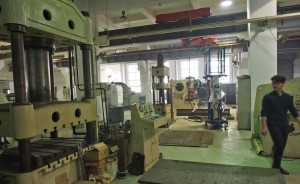
This picture appeared in my previous note. But it turns out to have even more relevance than ever to Tianjin University’s big move exile to the distant lands of old warehouses and weeds.
Almost no one I know has actually been out to see the new site, mainly because it’s not easy to travel out there. And yet, we’re already headlong in the process of moving. Yeah, moving like lemmings, in joyous ignorance of what we’ll find. But that’s okay. The move’s planners don’t know much more, either.
One of my colleague’s students toured the new site. He told her later that “the place has no soul.” Another colleague’s student visited there and exclaimed happily that, unlike most pieces of property in China, the campus had no enclosing wall. I guess she hadn’t noticed the moat?

Yeah, thousands of people will occupy the new site come fall. 99% of them don’t want to move. But there’s nothing to be done about stopping it. The old site’s real estate is too valuable to waste on students. The land along the main street has already been sold, and the buyers can’t wait to tear down the old dorms and build their new business park. And, to be fair to their evident impatience, I did once see a flyer about the new campus that set a date of 2013 for the opening. So it’s two years behind schedule.

As for me for next year, I will most likely teach one day a week in the new campus, and one day a week in the old campus, for the students who remain. Of course, nobody can say for sure, as we’re all lemmings in this process. Hey, there’s still two months to go. Plenty of time to sort things out.
How is it, though, that some students will remain in the old campus, despite its value as real estate? Couldn’t a business make more money from the site than a simple school? Well, this point brings me to my new understandings of business’s position in Chinese universities.

I’ve mentioned before that an architecture business is attached to our University. Its CEO sits at the same meeting table as all the heads of academic departments. The architecture business, as well as the associated academic architecture department, are not moving to the new campus. After all, clients seeking a design consultation like to meet the staff in town, not in some far-flung gulag. And the staff includes the students in the academic department. One of my former students, in fact, recently designed a railroad station for the business. So the academic department can’t move out there, either.
As for my own department, Culture and Law, it’s moving. This was a bit of a surprise to me, since our department includes the hallowed school of Marxism. But maybe it just goes to show the real position of Marxism in modern society.

Recently one of my English students had missed quite a few classes. He had never contacted me (as students generally would) about the reasons for his absences. So I asked his buddy in the class to talk to him. If he wasn’t going to return to class, he should inform me so that I could sign him up for English the following semester. Well, after that he came to class.
He also came to office hours to get caught up on what he had missed. And while he was there, I asked him where he’d been.

He was spending most of the week, every week, in Tanggu, the port town located about an hour’s journey southeast of here by light rail. That explained his difficulties in attending class. And while there, he was operating what he called a “distillation column,” which turns crude oil into petroleum, which can later be further refined into various petrochemical products.

I tried to imagine what sort of study he could be doing of such an established technology. But no, he assured me that he was doing no study there at all. So why was he out there? Because it was part of a business, loosely associated with Tianjin University through his academic adviser. And was he paid to do this work? Of course not. He’s a student. He simply does what’s asked of him. Actually he seemed to relish the idea of telling his adviser that some maniac English teacher (me) was so insistent that he attend class that who knows what might happen otherwise. And after that, the student regularly attended class. And he arrived on time.
So, yeah, business is a much more integral part of the university in China than it is here. And if part of the old campus will be developed into a business park, well, that’s simply a small extension to what’s going on there anyway.
The Move Begins

The big move formally began on May 18th. With great pomp and ceremony, various officials ushered a phalanx, not of staff, but of machines, out to the new campus. Maybe they figured that machines can’t complain or cry, so nothing would spoil the bright dawn of the new campus’s development.
These were not ordinary machines of course, but huge museum pieces that had occupied part of the mechanical engineering lab for at least sixty years. And I realized that I must have seen some of these machines during my recent tour of that building, a few weeks earlier. And I wondered if one of them might even have been the machine in the picture at the beginning of this note. It’s certainly big enough, grand enough.

Well, the machines didn’t cry or complain. However, when they reached their ultimate dispensation, it was discovered that neither the floor nor the foundation of the building was strong enough to support them! I don’t know exactly how this failure was discovered, nor how anybody could have let it happen, since no one has exactly been open about the situation. I only know that a mad scramble to install a new foundation and floor ensued.
And I suspect that the Move’s beginning will prove emblematic of the entire process. It’s not likely to go smoothly, nor are the new facilities likely to be fully ready. But until it happens, we’re standing between the bear of business and its cub of profit. It could be a stressful, though highly exciting, position. I wonder sometimes, though, if maybe I’m getting a little old for such excitement. We’ll see about that in September.
The Bridge Park
Well, this whole idea of businesses as part of a university goes against my cultural grain, but that’s just an example of how cultures differ, and not something for me to sit in judgment of. And when you think about it, besides chopsticks and lion dancers, there’s not much more basic to Chinese culture than entrepreneurship, and the dream of forming one’s own business. So it only seems fair to provide a concrete example of where this system has functioned well.

And that spectacular example is a public park that opens some breathing room in the midst of densely-populated Tianjin. It appears in the center of this photo taken from space by Google Earth.
The land had long stood idle. Other than some brief employment as an army shooting range, nobody had ever done anything with it. And that’s because of the high water table. All of Tianjin is sopping wet from rivers flowing in from every direction. That’s why so many canals are needed just to keep the rest of it solid. Indeed there’s yet another canal in the above satellite photo running from top to bottom right along the freeway.

No one had ever built on this plot of land because it flooded all the time. Warding off this water flow would be difficult and expensive. But as a park, it held promise. The assignment was given to a landscape architect business associated with Peking University in Beijing.
The professor and students planned a park that was both beautiful and practical — it could deal with the water through a series of catch basins and a large L-shaped lake, all held in place by dense plantings, some of native plant species, and some of imported ones. It could guard the neighborhood from floods while providing a peaceful public space.

China has a long history of working in harmony with nature, particularly with water, going all the way back to Yu the Great, over 3000 years ago. It’s thrilling to see this sensibility reasserting itself in the modern world.
And it’s wonderful to see Chinese architects doing it, when so often, even today, foreign architects are hired for the most important buildings.

The two photos here show the same set of reeds — seen from overhead and seen from across the lake. From across the lake they look like a common reed thicket, such as grows around the edges of most ponds. But the overhead view reveals cement blocks that allow the visitor to freely navigate through them, perhaps on the lookout for frogs and small waterfowl.
Each “hill” is planted with a different kind of flower, and the red elevated pathways form more bridges between them. They remind me of Mayan temples.

Actually, red lines are a key motif in everything this architectural group designs. Red lines crop up throughout the park, as well as in their other parks elsewhere.
Well, I think a few more pictures will speak more eloquently than anything I write. So at this point, I’ll simply paste a few in.


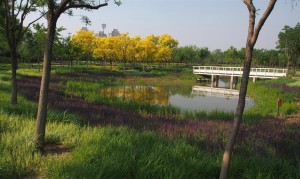
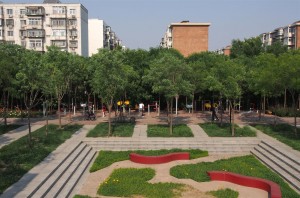
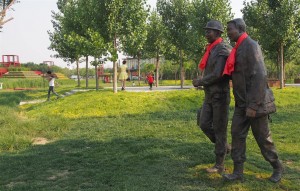


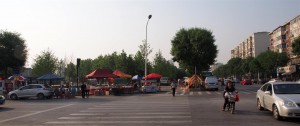




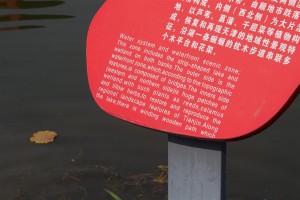
And, yeah, the presence of questionable English is the final mark of Chinese authenticity on this park. I’ll include one typical sign for your reading pleasure.
When I first saw scrambled English like this in China, I was annoyed. But now. . . . Okay, I’m still annoyed. I’m an English teacher, after all! But I’m also filled with warmth that this beautiful site is an authentically Chinese development, reflecting both the modern and traditional worlds.
Well, I hope you enjoyed the trip. If you get a chance, drop me a line.
I’ve actually been in town for exactly a week now, and today was the first day that I made it through the entire day without a single nap. And my word count here has passed 2000 so I’m now officially ready to venture out and do things. I’ll conclude with one final Bridge Park shot – a panorama taken from near the main entrance.
